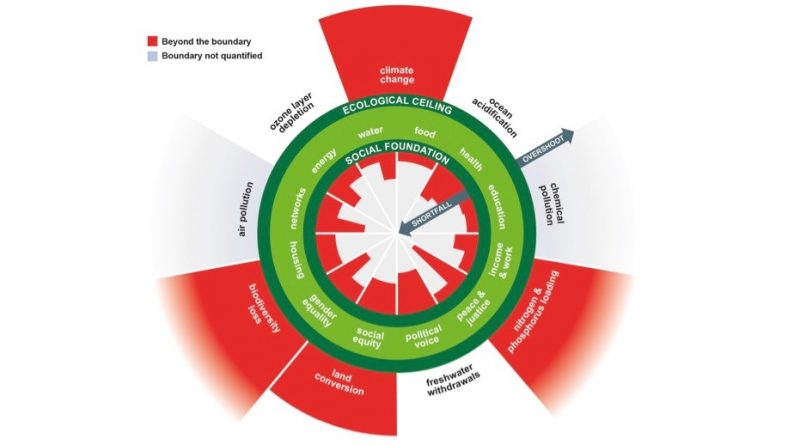Opinion: Love, Justice, And Climate Change. Doughnut Economics

Doughnut economics: Photo: Kate Raworth

In my previous post I raised the issue of “living lightly on the earth” — inviting us to think about our levels of consumption and what lifestyles are sustainable on a planet with 7.8 billion other humans. We will each need to make our own decisions about what a sensible and workable lifestyle is for us. As a society, we also need to think about a more sustainable and equitable economic system — what should be its goals and how can we bring it into being?
As I wrote last time, I’m intrigued by what I’ve learned so far about “Doughnut Economics.” First, there are no glazed or cream-filled pastries here — just an intriguing doughnut-shaped diagram that summarizes some important ideas. I believe we can all think about the most important issues facing our society. The “doughnut” approach provides us with an accessible entry point to some interesting and relevant perspectives on economic systems.
Thrive, Not Grow
Kate Raworth, the creator of this way of thinking about things, says that “a healthy economy should be designed to thrive, not grow.” She explains that we’ve been taught to see growth as the goal and this leads to problems. Despite tremendous growth in the global economy in the last 70 years, billions of people still live in poverty, an ever increasing percentage of wealth is going to a very few, and we are “rapidly destabilizing this delicately balanced planet on which all of our lives depend.” Some transformative changes are needed.
She writes, “Humanity’s 21st century challenge is to meet the needs of all within the means of the planet [emphasis added]. In other words, to ensure that no one falls short on life’s essentials (from food and housing to healthcare and political voice), while ensuring that collectively we do not overshoot our pressure on Earth’s life-supporting systems, on which we fundamentally depend.”
Why “Doughnut?”
The key graphic representation of doughnut economics begins with a large circle labeled “ecological ceiling.” Placed around it are nine “planetary boundaries.” These are areas where human activity has exceeded, or threatens to exceed, the levels required for a stable and hospitable environment — such things as climate change, biodiversity loss, and depletion of the ozone layer. Outside this boundary lies overshoot — “unacceptable environmental degradations and potential tipping points in earth systems.”
A smaller circle, inside the first one, is labeled “social foundation“. Around that one are 12 dimensions of internationally agreed upon minimum social standards derived from the UN Sustainable Development Goals of 2015 — water, education, health, social equity, housing, etc. The hole in the middle represents a shortfall in basic needs — where people don’t have enough.
As Raworth describes it, “Between social and planetary boundaries lies an environmentally safe and socially just space in which humanity can thrive” — the light green doughnut shape in the diagram below.
Photo: Kate Raworth.
Here’s a minute and a half video summary of her framework.
Regenerative By Design
Raworth goes on to say that we’ve inherited degenerative industries that take the earth’s materials and make stuff we want, for us to use briefly (sometimes only once), and then throw away. This is destroying our environment and destabilizing planetary systems. Instead we need economies in which resources are never used up or discarded, but consistently used again and again; where the waste from one process is food for the next. In other words, we can design our economy to be circular, rather than linear — a much better fit with the natural world.
Distributive By Design
Similarly, we currently have economies that “concentrate wealth, knowledge and power in few hands.” This inequitable concentration is happening all over the world. No matter what rhetoric is used to try to cover it over, this is the inevitable effect of our economies as they are currently designed. Instead, we can redesign our economies to be distributive – to distribute wealth, knowledge and empowerment to the many.
The recent federal $1.9 trillion COVID relief bill will reportedly cut child poverty in the U.S. in half (as long as its tax credits are continued). We know how to redistribute wealth, if we make the policy choices to do so. Distributed solar power is beginning to empower local communities and can improve the efficiency and reliability of the system. As individuals we can patronize and support the expansion of “social enterprises” — business entities whose primary reason for being is to improve social objectives and serve the common good, rather than prioritizing shareholder profits. Public banks, similar to the Bank of North Dakota, may provide a way to create financial institutions serving the public good rather than extracting profits for the already wealthy.
Economic Systems Can Be Changed
Just entertaining and sharing the idea that our current economic system is neither optimal, nor inevitable, nor unchangeable can lay the groundwork for change. The idea that we could have an economic system in which everyone has their basic needs met, in which all people can thrive without threatening the environment, and which is not based on dividing people and setting us against each other, is revolutionary.
Ideas of social justice and equity for all are inherent in the basic structure of this approach. Raworth and her colleagues don’t have it all worked out yet, but they do have some very promising ideas. Changing the goal of our economic system and being regenerative and distributive by design, seem to me to be excellent starting points. Perhaps these ideas can help us build sustainable economies that fit the needs of the 21st century, live lightly on the earth, and achieve climate justice.
Other resources:
Seven one-and-a-half-minute animated videos explaining the basic ideas of Doughnut Economics, including “Create to Regenerate” and “Design to Distribute” are at: https://doughnuteconomics.org/tools-and-stories/2
TED talk — engaging 16 minute overview by Kate Raworth A healthy economy should be designed to thrive, not grow | Kate Raworth
There’s a somewhat interactive version of the doughnut at https://www.kateraworth.com/doughnut/ The data is not updated, but moving your cursor over each red area yields some key facts.
Russ Vernon-Jones was the Principal of Fort River Elementary School from 1990 to 2008. He is a co-facilitator of the Coming Together Anti-Racism Project in the Amherst area. He chairs the Racism, White Supremacy, and Climate Justice working group of Climate Action Now of Western Mass., and blogs regularly on climate justice at www.RussVernonJones.org.

1 thought on “Opinion: Love, Justice, And Climate Change. Doughnut Economics”